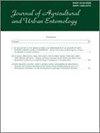Field and Laboratory Evaluation of d-Limonene, Mineral Oil, and Potassium Salts of Fatty Acid against Nysius raphanus (Hemiptera: Lygaeidae)
Q2 Agricultural and Biological Sciences
引用次数: 0
Abstract
ABSTRACT The false chinch bug, Nysius raphanus Howard (Hemiptera: Lygaeidae), is a pest of a wide range of plant species. The efficacies of d-limonene (applied at 0.2, 0.3, 0.5, 1, and 1.5 g a.i./L), mineral oil (applied at 5, 8, 10, 20, and 24 g a.i./L), and potassium salts of fatty acid (applied at 0.05, 0.1, 0.2, 0.4, and 0.6 g a.i./L) against adults and nymphs (10-d-old) were evaluated in laboratory bioassays and under field conditions. Phytotoxicity of the same insecticides and doses to Portulaca oleracea L. (Portulacaceae) was also documented in the laboratory. In the laboratory topical contact toxicity bioassays, d-limonene at 1 and 1.5 g a.i./L, and mineral oil at 20 and 24 g a.i./L were the most effective treatments, causing 97% to 100% mortality at 48 h after application. In residual toxicity bioassays, d-limonene at 1 and 1.5 g a.i./L, and mineral oil at 20 and 24 g a.i./L caused 92% to 100% mortality among nymphs and adults exposed to the treated P. oleracea at 48 h after introduction. In the field experiment, d-limonene at 1.5 g a.i./L and mineral oil at 24 g a.i./L were effective in reducing 98% to 100% of adult and nymphal populations at 6–12 d after treatment. Results of this study suggested that d-limonene at 1.5 g a.i./L and mineral oil at 24 g a.i./L could be used to manage infestation by N. raphanus.d-柠檬烯、矿物油和脂肪酸钾盐对小夜蛾(半翅目:小夜蛾科)的田间和室内评价
假蠓(Nysius raphanus Howard)(半翅目:蠓科)是一种广泛危害植物的害虫。在实验室生物测定和野外条件下评估了d-柠檬烯(0.2、0.3、0.5、1和1.5 g a.i./L)、矿物油(5、8、10、20和24 g a.i./L)和脂肪酸钾盐(0.05、0.1、0.2、0.4和0.6 g a.i./L)对成虫和10 d龄若虫(10 d龄)的防治效果。同样的杀虫剂和剂量对马齿苋(马齿苋科)的植物毒性也在实验室进行了记录。在实验室局部接触毒性生物测定中,1和1.5 g a.i./L的d-柠檬烯和20和24 g a.i./L的矿物油是最有效的处理,在施用后48 h死亡率为97%至100%。在残留毒性生物测定中,d-柠檬烯浓度为1和1.5 g a.i./L,矿物油浓度为20和24 g a.i./L,在引入后48 h,暴露于处理过的马齿菊的若虫和成虫死亡率为92% ~ 100%。在田间试验中,1.5 g a.i./L d-柠檬烯和24 g a.i./L矿物油处理后6 ~ 12 d,成虫和若虫数量减少98% ~ 100%。研究结果表明,1.5 g a.i./L的d-柠檬烯和24 g a.i./L的矿物油可以有效地防治褐家蝇的侵害。
本文章由计算机程序翻译,如有差异,请以英文原文为准。
求助全文
约1分钟内获得全文
求助全文
来源期刊

The Journal of Agricultural and Urban Entomology
Agricultural and Biological Sciences-Insect Science
CiteScore
1.40
自引率
0.00%
发文量
2
期刊介绍:
The Journal of Agricultural and Urban Entomology (JAUE) (Journal of Agricultural Entomology, Jan 1984 - Oct 1998 volumes 1-15) is published under the auspices of the South Carolina Entomological Society (SCES). The Journal publishes contributions of original research concerning insects and other arthropods of agricultural and urban importance to include those affecting humans, livestock, poultry, and wildlife. JAUE is particularly dedicated to the publication of articles and notes pertaining to applied entomology, although it will accept suitable contributions of a fundamental nature related to agricultural and urban entomology.
 求助内容:
求助内容: 应助结果提醒方式:
应助结果提醒方式:


